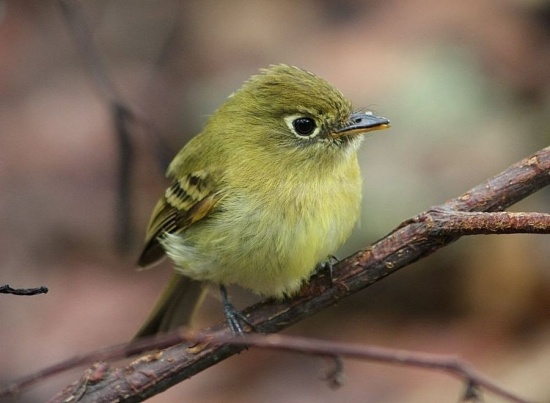(id, habitat) |
(Basic tidy-up. C/right. References updated) |
||
| Line 1: | Line 1: | ||
| − | [[Image:Yellowish_Flycatchera.jpg|thumb|550px|right|Adult<br />Photo by {{user|firecrest15|firecrest15}}<br />Savegre riverside forest, [[Costa Rica]]]] | + | [[Image:Yellowish_Flycatchera.jpg|thumb|550px|right|Adult<br />Photo © by {{user|firecrest15|firecrest15}}<br />Savegre riverside forest, [[Costa Rica]], 3 May 2009]] |
;[[:Category:Empidonax|Empidonax]] flavescens | ;[[:Category:Empidonax|Empidonax]] flavescens | ||
==Identification== | ==Identification== | ||
| − | Length: 12.5cm (5in) | + | Length: 12.5cm (5in)<br /> |
| − | '''Adult:''' sexes similar; greenish-olive above; blackish wings with ochraceous-buff wing-bars; breast ochraceous yellow, fading to yellow in the belly; prominent eye-ring very pale yellow, broader behind the eye as in the [[Black-capped Flycatcher]]; upper mandible black, lower orangey; legs are gray. | + | '''Adult:''' sexes similar; greenish-olive above; blackish wings with ochraceous-buff wing-bars; breast ochraceous yellow, fading to yellow in the belly; prominent eye-ring very pale yellow, broader behind the eye as in the [[Black-capped Flycatcher]]; upper [[Dictionary_M-O#M|mandible]] black, lower orangey; legs are gray.<br /> |
| + | '''Young:''' browner above, paler yellow below, with belly almost white; wing-bars are cinnamon-orange. | ||
====Similar species==== | ====Similar species==== | ||
| − | + | [[Image:Yellowish_Flycatcher.jpg|thumb|350px|right|Juvenile<br />Photo © by {{user|HelenB|HelenB}}<br />Savegre Lodge, [[Costa Rica]], February 2007]] | |
| − | [[Image:Yellowish_Flycatcher.jpg|thumb|350px|right|Juvenile<br />Photo by {{user|HelenB|HelenB}}<br />Savegre Lodge, [[Costa Rica]], February 2007]] | + | Despite the name, adults are overall a brighter yellow than the [[Yellow-bellied Flycatcher]] (''Empidonax flaviventris''), a migrant flycatcher, which breeds in Canada and extreme North East [[USA]] and winters in [[Central America]]. |
| + | |||
==Distribution== | ==Distribution== | ||
| − | Resident from | + | Resident from South East [[Mexico]] to West [[Panama]]. |
==Taxonomy== | ==Taxonomy== | ||
| + | ====Subspecies==== | ||
There are three subspecies:<sup>[[#References|[1]]]</sup> | There are three subspecies:<sup>[[#References|[1]]]</sup> | ||
*''E. f. imperturbatus'' | *''E. f. imperturbatus'' | ||
| Line 21: | Line 24: | ||
Cool cloud forests of the mountains, between 800m (2600ft) and 2450m (8000ft). Frequents edges, openings, clearings, shady pastures and second growth. Mainly found in the lower and middle parts of the forest, not in the canopy. | Cool cloud forests of the mountains, between 800m (2600ft) and 2450m (8000ft). Frequents edges, openings, clearings, shady pastures and second growth. Mainly found in the lower and middle parts of the forest, not in the canopy. | ||
==Behaviour== | ==Behaviour== | ||
| − | Sallies forth from a perch to catch insects, gleans them from foliage and bark while hovering, and also drops to the ground for insects and spiders; sometimes eats berries. Usually seen alone outside of the breeding season. | + | ====Diet==== |
| + | Sallies forth from a perch to catch insects, gleans them from foliage and bark while hovering, and also drops to the ground for insects and spiders; sometimes eats berries. Usually seen alone outside of the breeding season. | ||
| + | ====Breeding==== | ||
| + | Breeds from March to June, building a deep cup of mosses and liverworts, lined with plant fibers and horsehair. The nest is placed 2-4.5m (6-15ft) up, in a crevice in big tree trunks, an earthen bank or cliff. | ||
| + | ====Vocalisation==== | ||
| + | Dawnsong during the breeding season, a ''seee seee chit'', about 20 times per minute; otherwise a thin high-pitched ''tseeep''. | ||
==References== | ==References== | ||
| − | #{{Ref- | + | #{{Ref-Clements6thAug18}}#Birdforum Member observations |
| + | {{ref}} | ||
==External Links== | ==External Links== | ||
{{GSearch|Empidonax+flavescens}} | {{GSearch|Empidonax+flavescens}} | ||
[[Category:Birds]] [[Category:Empidonax]] | [[Category:Birds]] [[Category:Empidonax]] | ||
Revision as of 22:47, 26 April 2019
- Empidonax flavescens
Identification
Length: 12.5cm (5in)
Adult: sexes similar; greenish-olive above; blackish wings with ochraceous-buff wing-bars; breast ochraceous yellow, fading to yellow in the belly; prominent eye-ring very pale yellow, broader behind the eye as in the Black-capped Flycatcher; upper mandible black, lower orangey; legs are gray.
Young: browner above, paler yellow below, with belly almost white; wing-bars are cinnamon-orange.
Similar species
Despite the name, adults are overall a brighter yellow than the Yellow-bellied Flycatcher (Empidonax flaviventris), a migrant flycatcher, which breeds in Canada and extreme North East USA and winters in Central America.
Distribution
Resident from South East Mexico to West Panama.
Taxonomy
Subspecies
There are three subspecies:[1]
- E. f. imperturbatus
- Southern Mexico
- E. f. salvini
- E. f. flavescens
- Highlands of Costa Rica and western Panama
Habitat
Cool cloud forests of the mountains, between 800m (2600ft) and 2450m (8000ft). Frequents edges, openings, clearings, shady pastures and second growth. Mainly found in the lower and middle parts of the forest, not in the canopy.
Behaviour
Diet
Sallies forth from a perch to catch insects, gleans them from foliage and bark while hovering, and also drops to the ground for insects and spiders; sometimes eats berries. Usually seen alone outside of the breeding season.
Breeding
Breeds from March to June, building a deep cup of mosses and liverworts, lined with plant fibers and horsehair. The nest is placed 2-4.5m (6-15ft) up, in a crevice in big tree trunks, an earthen bank or cliff.
Vocalisation
Dawnsong during the breeding season, a seee seee chit, about 20 times per minute; otherwise a thin high-pitched tseeep.
References
- Clements, J. F., T. S. Schulenberg, M. J. Iliff, D. Roberson, T. A. Fredericks, B. L. Sullivan, and C. L. Wood. 2018. The eBird/Clements checklist of birds of the world: v2018. Downloaded from http://www.birds.cornell.edu/clementschecklist/download/
- Birdforum Member observations
Recommended Citation
- BirdForum Opus contributors. (2024) Yellowish Flycatcher. In: BirdForum, the forum for wild birds and birding. Retrieved 5 May 2024 from https://www.birdforum.net/opus/Yellowish_Flycatcher





